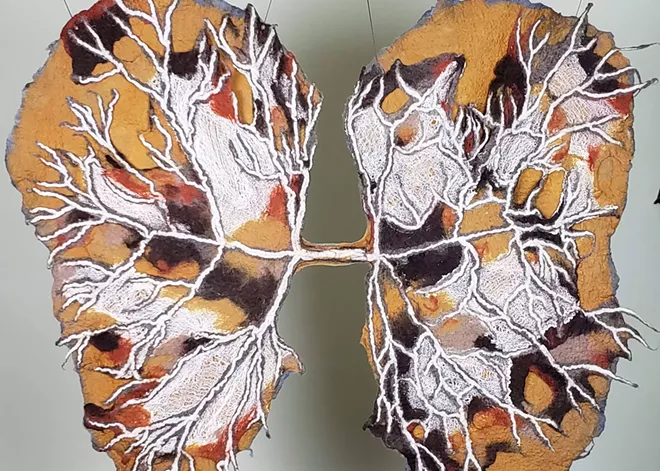
Elyse Hochstadt works with her hands and her head, but also her heart.
Serving as the executive director of the nonprofit Spokane Zero Waste for the past two years, Hochstadt is constantly thinking about the planet and how humans can reduce their environmental impact.
When she began graduate school at the San Francisco Art Institute in 2002, she quickly became invested in efforts to address the plastic pollution crisis, abandoning her ceramics practice.
"I was really grappling with questioning why I was making art when the world is falling apart," Hochstadt says. "I felt like I needed to be doing something significant. Now I understand that art is hugely significant in so many ways."
After living in the Bay Area for over a decade, Hochstadt moved to Spokane right as COVID hit. She found herself needing a creative outlet and picked up needle felting after taking an online course. It wasn't until taking another course from a Danish artist that she found her calling in the medium of wet felting.
"My mind was blown," she says. "I could not believe what you could do with this material. It was a pivotal moment in my way of thinking about felt as a sculptural material, and it really changed everything."
The wet felting process begins by laying out sections of wool roving — unspun wool fibers — on top of one another to form a thick layer that can then be formed into a larger piece of felt using friction, soapy water and heat. The wool fibers interlock and can form 2D or 3D designs depending on the artist's vision.
"I tend to be somebody who works based on my passion," Hochstadt says. "Right now that's the relationship humans have to the natural world and helping people build that relationship back to being part of the natural world and respecting what that means. We are so interconnected with the land, resources, air, water — all of it."
Last March, Hochstadt held an event at Shotgun Studios in Peaceful Valley using wet felting as a way to deal with feelings associated with climate grief. Each participant crafted a wet felt teardrop while sharing and listening to others talk about their climate-related anxieties. The felt art became a wool sculpture titled "River of Tears."
Hochstadt says there's something special about using natural fibers to create organic shapes and sculptures.
"This material is from nature," she says. "If it's not heavily dyed with chemical dyes, you can bring it right back to nature. It will compost in the future."
Along with wet felting, Hochstadt incorporates stitching, hand embroidery and needle felting to tell stories in her work. She's created wool flowers, seed pods, mushrooms, rabbits, birds, words and more. She combines the felt with other objects to create critters and structures that express her passions. (See examples of this work on Instagram, @tangledwoolstudio.)
"I imagine myself as a distillery," she says. "There's all of this information coming in, and then there's this moment of transformation. It all comes out in some manner. The pieces tell stories, but the stitch work really adds this element that I think is so of the hand and of the body, it feels like you can communicate in a different way."
As part of her job at Spokane Zero Waste (learn more at spokanezerowaste.org), Hochstadt is in the process of starting a "regional fiber industry" based on the model of a nonprofit organization called Fibershed.
"We have a ton of fiber artists in this region," she says. "We have weavers, knitters, dyers, spinners, the whole thing. The idea is to create a soil-to-soil system starting with the people that are grazing the sheep to the people processing the fiber to the people making the textiles."
"The pieces tell stories, but the stitch work really adds this element that I think is so of the hand and of the body, it feels like you can communicate in a different way."
tweet this
Hochstadt also hopes to aid the region in moving away from fast fashion toward a mindset of buying garments made to last a decade or longer, and only a few new pieces a year.
"We are at a really fragile point in human history right now," she says. "So all of my work, art and other, is inspired by that. I want to have my hands in it, poised to help and ready for that transformation." ♦


